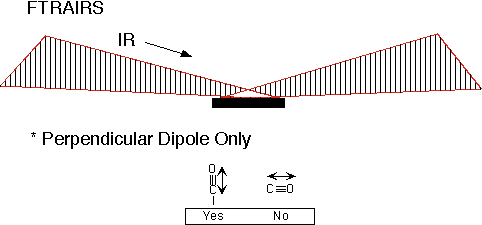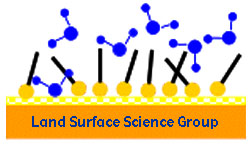Land Surface Science Group
Fourier Transform Reflection Absorption Infrared Spectroscopy (FT-RAIRS)
With FTRAIRS, one reflects a beam of broadband infrared radiation off of a polished surface at grazing incidence. Greenler, et al, showed that this maximizes the electric field at the surface. Molecules near the interface can absorb some of this IR radiation, but only if the dipole moment for the transition is perpendicular to the plane of the surface. Radiation polarized parallel to the surface plane has a near zero electric field near the surface. Thus, one can obtain an IR absorption spectrum for adsorbed species, yielding molecular identity information. At the same time, one obtains information on the molecular orientation due to this "surface selection rule." A good example is benzene adsorption on Pt(111) . At low coverages, the molecules lie flat and only out-of-plane modes are observed in FTRAIRS. The second layer of molecules adsorbed perpendicular to the first; thus, in-plane benzene modes become observable at higher coverages.

Attenuated Total Reflection Fourier Transform Infrared Spectroscopy (ATR-FTIR)
With ATR-IR, one directs a beam into a highly polished crystal. The beam enters the crystal at such an angle that subsequent interaction within the crystal occurs above the angle of incidence, so the light is completely internally reflected. Some portion of this light, however, is transmitted through to the surface in the form of an evanescent wave.
Normally, this evanescent wave extends beyond the crystal far enough to interact with the bulk solution beyond the interface. Whn attempting to study protein systems, however, the bulk solution is often aqueous, which can interfere with the IR signal from the proteins. To overcome this obstacle, the proteins can be bound to a gold surface deposited on the crystal surface. When the IR radiation is transmitted through the crystal surface, it excites the metal film, causing surface plasmon resonance. Any molecules bound to this gold surface with dipole moments of their own cause perturbations in the plasmon resonance, causing absorption at wavelengths other than that which is characteristic of the metal film. The remaining IR radiation is scattered back into the crystal, where it may be directed to the detector. The gold film acts as an amplifier at the surface of the crystal, increasing the surface specificity of the this technique.
The absorption of a particular system is based on three parameters: the angle of incidence, the wavelength of light used, and the refractive index of both the crystal and the substrate being analyzed. The closer that one operates to the critical angle (the angle at which the light is first internally reflected, which is dependent on the two refractive indices), the greater the absorption signal noted. This is because the amount of radiation being transmitted is greatest at this angle. On the other hand, the surface specificity suffers close to the critical angle, as the radiation penetrates farther into the bulk phase. For this reason, difference types of crystals are used for different studies. For aqueous phase studies, where surface specifity is very important, germanium crystals with gold coatings are used, since the high refractive index of germanium (4.01) combines with the amplification of the gold raises the extinction coefficient for the IR radiation. For solid-phase studies, however, where the emphasis is on the location of trace components, the surface selectivity is less important than the signal-to-noise ratio, so zinc selenide crystals (refractive index of 2.41) with no overlayer are used. There are a variety of other crystals available, but these are the two main crystals being used by the Land group.








